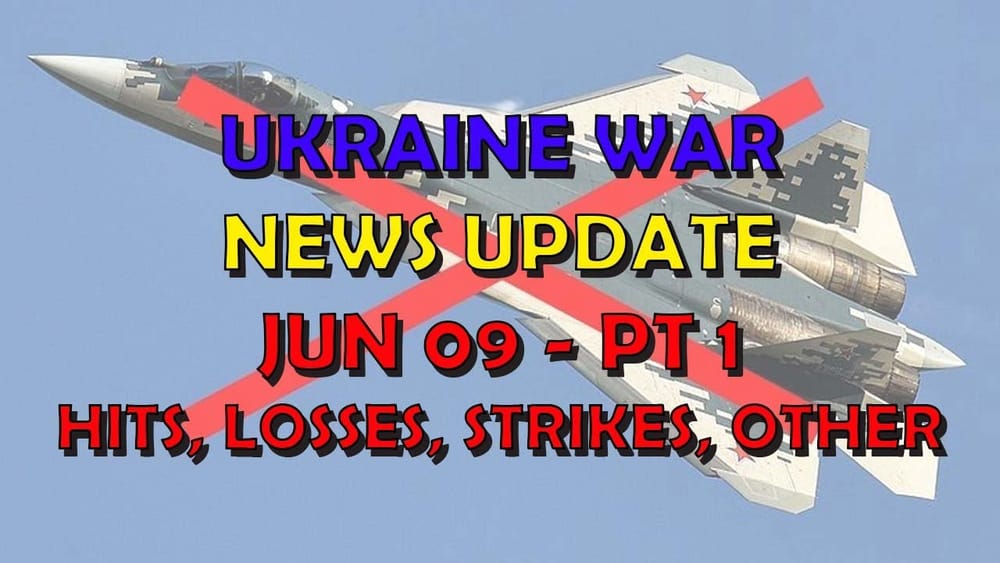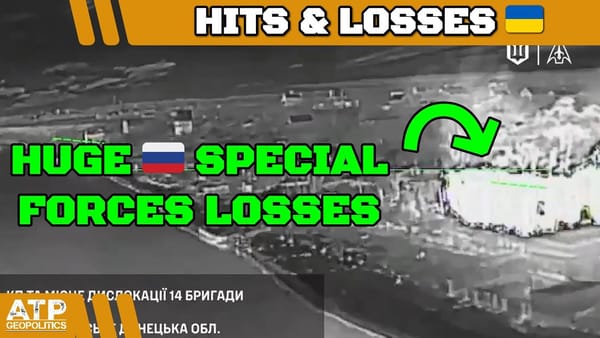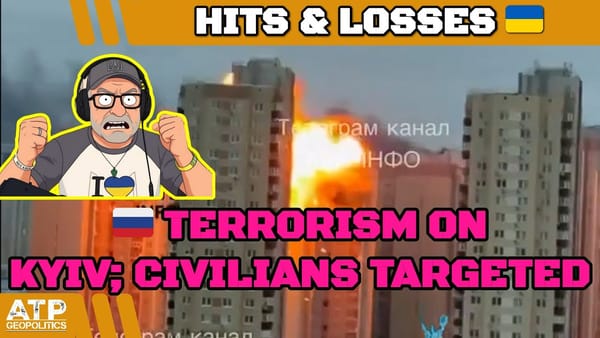Ukraine War Update NEWS: Pt 1 - Overnight & Other News
Table of Contents 📖
"Russia is in serious freaking trouble...it is a massive country geographically speaking it has so many targets inside Russia in terms of military targets, critical infrastructure...It's got military installations all over the shop. It's got other critical infrastructure to do with internal security or politics or whatever."
Hello Team
🎦 00:00-00:08⏩
Jonathan welcomes viewers to another video on the war in Ukraine. This is the first part of his Ukraine War Update for 9th June 2024 and will focus on overnight news.
Return to top⤴️
🪦 DISCLAIMER FOR GENERAL STAFF LOSSES DATA
- These are real people with real lives and real families who love them. Don’t let the numbers sap your humanity.
- These numbers probably aren’t accurate but they’re the best we have and we don’t need them to be accurate to be indicative of patterns of activity.
- All losses are estimates. Losses cannot be counted with accuracy because of the conditions on the ground.
- Both sides would see it to be of their advantage to minimize their own losses maximize the other side’s losses.
- Neither side releases their losses but we have enough transparency from the Ukrainian side to have confidence in they are indicative.
- Personnel losses are hard to count. If a soldier gets injured, heals up, and returns to the front line only to get injured again, is that one loss or two? Also, how to deal with losses from PMC’s or soldiers fighting with RF from occupied territories?
- Equipment losses are hard to count. If an AA complex involves several parts and one part gets disabled, is that a loss, or a fraction of a loss? If a tank gets disabled, repaired, back into the fight, then disabled again, is that one lost tank or two?
- All recorded losses are vulnerable to multiple reporting. We have already seen numerous cases of multiple drones in the air reporting the same loss from different angles as multiple engagements.
- Losses are not always reported on the same day they occurred. It is frequent that drone losses are reported at least 24 hours after other terrestrial equipment losses. Certain losses may not be reported for days or weeks for military intelligence reasons.
Ukrainian General Staff Report - 8th June 2024
🎦 00:08-02:11⏩
Jonathan begins by examining figures released by the Ukrainian General Staff for Russian losses on 8th June 2024, acknowledging the need for caution with these figures. He notes:
- Personnel losses: 1,270 (consistent with recent weeks)
- Tank losses: 26 (a significant increase from previous days)
- Armoured Personnel Vehicle (APV) losses: 26 (also a notable rise)
- Artillery system losses: 60 (an exceptionally high number)
- Multiple Launch Rocket System (MLRS) losses: 2
- Anti-aircraft systems losses: 2
- Vehicle and fuel tank losses: 78 (remarkably high)
Jonathan highlights the substantial increase in equipment losses compared to the previous day, suggesting a successful period for Ukrainian forces. Even with a potential 30% margin of error, the losses remain considerable. Jonathan refers to data from Oryx, which visually confirmed 57 Russian equipment losses, further supporting the claim of a difficult day for Russian forces. Based on these figures, he estimates the loss ratio to be 4:1 (Russian to Ukrainian), a disadvantageous position for the Russians.
Return to top⤴️
Analysis of Ukrainian Equipment Losses - 8th June 2024
🎦 02:11-03:13⏩
Jonathan analyses Ukrainian equipment losses, noting a number of less valuable vehicles lost, but highlights some significant losses:
- AMTPQ-50 radar system destroyed by a Lancet loitering munition
- Panzerhaubitze 2000 self-propelled howitzer destroyed by Krasnopol laser-guided artillery
- Two tanks
- A damaged and a destroyed BMP and M113
Jonathan considers the loss of the Panzerhaubitze 2000 to be particularly significant.
Return to top⤴️
Analysis of Russian Equipment Losses - 8th June 2024
🎦 03:13-04:20⏩
Jonathan details visually confirmed Russian equipment losses, which includes:
- A damaged Buk-M2 air defence system
- A destroyed electronic warfare system
- Three engineering vehicles
- Two BM-21 Grad MLRS
- Various tanks: T-80 variants, T-72s, and T-62s
- Six infantry fighting vehicles (BMP-1, BMP-2, BMP-3, and BMDs)
- Numerous APCs, trucks, all-terrain vehicles, quad bikes, motorbikes, cars and vans.
Jonathan observes that, although both sides suffered losses, the volume of Russian equipment lost significantly surpasses that of Ukraine.
Return to top⤴️
Russian Desertions
🎦 04:20-05:35⏩
Jonathan discusses the increasing number of Russian desertions. He shares a report, based on an official Russian document, revealing that 115 soldiers from a single regiment have not returned from vacation. He explains that this pattern of desertion is a key reason why Russia has been hesitant to allow troop rotations back to Russia, opting to confine R&R periods within occupied Ukrainian territories. Permitting soldiers to return home significantly increases the chance of them not returning to the front. Jonathan suggests that the Russian military is attempting to address this issue by detaining deserters and forcing them into dangerous frontline assaults.
Return to top⤴️
Footage of Russian Casualties
🎦 05:36-06:10⏩
Jonathan references footage (link in the video description) of Russian soldiers from the K2 battalion attempting to storm Ukrainian positions, resulting in an estimated 60 Russian casualties. He emphasises the heavy losses the Russians continue to endure.
Return to top⤴️
Ukrainian Strike on Russian Su-57
🎦 06:10-14:50⏩
Jonathan discusses the most significant news of the day: a Ukrainian strike on a Russian Su-57 fifth-generation fighter jet. He highlights that the Su-57s, although touted as advanced aircraft, have seen very limited use in the conflict. He cites several reasons for this, including:
- Limited Numbers: Only an estimated 20 Su-57s are in service.
- Export Concerns: The Russian military fears that any battlefield losses or exposure of poor performance by the Su-57 would jeopardise potential foreign sales.
- Technical Issues: The aircraft is believed to still be plagued by technical shortcomings.
Jonathan references a comment by Sir Smil, suggesting that in operational terms, Russia only has around six functional Su-57s. The recent strike reportedly damaged one of these aircraft at Akhtubinsk airbase, 600km from the frontline. Jonathan explains that this damage likely occurred during a Ukrainian drone attack on the base, supported by satellite imagery from Ukrainian intelligence showing traces of drone strikes near a Su-57. While the full extent of the damage is unclear, any compromise to the stealth coating would render the aircraft operationally ineffective. Jonathan emphasises the cost-effectiveness of Ukrainian drone strikes. He suggests that for the price of a single Su-57, Russia could have implemented robust drone protection measures for all of its military aircraft, a persistent criticism levelled at the Russian military for their inadequate protection of assets, particularly airbases. He notes comments from various sources, including Oryx, highlighting the symbolic blow dealt to Russia's military prestige and the potential for retaliatory attacks. Jonathan goes on to explore the strategic logic of deploying the Su-57 given its limited capabilities in the context of the current conflict, comparing it to the problematic T-14 Armata tank programme, which has also been beset by delays and technical challenges.
Return to top⤴️
Russian Offensive Operations
🎦 15:02-19:06⏩
Jonathan analyses footage of a Russian assault near Krasnoyarsk, in the Marinka direction, noting the continued trend of smaller-scale attacks, usually involving no more than five vehicles. In the footage, four out of five Russian vehicles, including a 'track garden shed' (likely an improvised armoured vehicle), were destroyed by Ukrainian drones. He highlights the growing significance of drones in the conflict, effectively replacing artillery in many scenarios due to ammunition shortages and increased drone lethality. Jonathan believes that drone strikes are proving increasingly effective, particularly against armoured vehicles, due to their availability in large numbers, allowing for multiple attacks on a single target even with a relatively low success rate. He discusses the diminishing prospect of large-scale combined manoeuvre warfare by either side in the current operational environment. He argues that both sides seem entrenched and prepared to absorb losses inflicted by these smaller-scale attacks. While Russia might make marginal territorial gains by capturing small villages, the cost in terms of personnel and equipment losses makes these victories strategically insignificant in the long term. Jonathan believes Ukraine's best opportunity for a decisive counteroffensive would be to wait for further weakening of the Russian position, likely due to economic and political pressures, before launching a large-scale assault.
Return to top⤴️
Assassinations
🎦 19:07-20:16⏩
Jonathan reports on a series of incidents targeting individuals suspected of collaborating with Russian forces. He notes:
- The former mayor of Kupyansk is in critical condition following an assassination attempt, highlighting the risks faced by those who side with Russia.
- Dmitry Kovrin, who assumed control of an energy company after collaborating with Russian authorities in Melitopol, was found dead under suspicious circumstances.
- A policeman named Danio Udod, also suspected of collaboration, was reportedly killed by Russian forces.
Jonathan acknowledges uncertainty about whether these deaths were targeted assassinations or a result of other factors but highlights the growing attrition among those collaborating with the Russian administration in occupied territories.
Return to top⤴️
Possible Sinking of Russian Ship
🎦 20:16-29:22⏩
Jonathan speculates on the possibility of a significant Russian naval loss near Crimea. Despite a relatively quiet night regarding strikes, reports suggest that Ukrainian naval drones might have sunk a Russian ship near the Sea of Azov. He notes:
- Reports of a Ukrainian drone attack on a Russian vessel near the port of Yeysk around midnight.
- The targeted ship’s subsequent disappearance from satellite tracking, along with the deletion of online reports about the incident.
- Conflicting information regarding the type and location of the attack, with initial claims suggesting the sinking of a large landing ship contradicted by later reports.
- Analysis of satellite imagery by the "Crimean Wind" monitoring group indicating the presence of a 96m long ship (not a large landing ship which are 112-113m long) near Yeysk on the morning after the reported attack. This ship, potentially a Project 22160 patrol ship (94m long), aligns with the dimensions observed in the satellite data.
- The appearance of a new oil slick in the area, further supporting the possibility of a ship sinking.
Jonathan believes that a Russian ship was likely sunk but acknowledges the need for further confirmation, particularly footage from the attack, which is typically released with the "Magura-5" sea drones.
Return to top⤴️
Russian Soldier's Testimony
🎦 29:22-30:50⏩
Jonathan highlights the experiences of a captured Russian soldier, Konstantin Sergey Yavich Romanyuk, revealing low morale and resentment from locals in the Donbas:
- Romanyuk, who joined the military for financial reasons, claims that Russian forces are viewed as occupiers and disliked even in areas supposedly sympathetic to Russia.
- Romanyuk supports earlier reports of barrier troops being deployed, claiming that conscripts with orders to shoot retreating soldiers and deserters are stationed on the border in the Belgorod region.
- Another unnamed Russian soldier claims that casualties and desertions are significantly impacting Russian force strength. He estimates that only 100-200 soldiers remain from his original battalion and that the 9th regiment has suffered 2,000-2,500 casualties or desertions.
Jonathan acknowledges that these accounts should be treated with caution, but their consistency with previous reports paints a bleak picture of Russian morale and operational effectiveness.
Return to top⤴️
Torture of Ukrainian Prisoners of War
🎦 30:50-31:31⏩
Jonathan shares a statement from the Ukrainian attorney general indicating that up to 90% of Ukrainian prisoners of war (POWs), including civilians detained by Russian forces, have endured torture. He asserts that this evidence further exposes the brutality of the Russian campaign and reinforces the distinction between the aggressor and the victim in the conflict.
Return to top⤴️
Suppression of Freedom of Speech in Russia
🎦 31:31-32:11⏩
Jonathan condemns the sentencing of a Russian Twitch streamer to over five years in prison for broadcasting eyewitness accounts of the Bucha massacre, a clear example of the suppression of freedom of speech in Russia. He uses this case to illustrate the lack of basic freedoms and the severe consequences for dissent in Russia.
Return to top⤴️
Wrap up
🎦 32:11-32:17⏩
Jonathan thanks viewers for watching, asking them to like, subscribe and share the video.
Return to top⤴️



